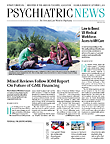To ban, or not to ban, was the question at the spring meeting at which members of an advisory panel of the Food and Drug Administration (FDA) recommended that the agency should prohibit the use of class II electrical stimulation devices (ESDs) for aversive conditioning in patients with nonsuicidal self-injuries or aggressive behaviors.
The decision was made after the majority of the members of the Neurological Devices Panel agreed that based on available data and information, the devices pose “an unreasonable and substantial risk of illness or injury” to patients.
“The data [supporting the use of ESDs] is more than 50 to 55 years old,” said Steven Miles, M.D., a professor of medicine and bioethics at the University of Minnesota Medical School, at the meeting. “I can’t think of any other comparable risk therapy that is allowed to persist on such old data.” The panel also expressed opposition to any new clinical trials involving the use of ESDs, deeming such practices as unethical.
Four class II ESDs are being marketed in the United States, all of which were cleared for usage between 1976 and 1994. The devices consist of a battery, an electric-pulse generator, electrodes that are attached to the skin on the trunk or extremities, and either a built-in accelerometer or a radio-controlled actuator to deliver the pulse. The devices are approved to be used at voltage ranges between 150 volts and 200 volts from 0.5 seconds to 12 seconds shock duration; they are typically used in individuals who have severe autism or development disabilities or who have repeatedly injured themselves or others through behaviors such as eye gouging, skin pinching, hair pulling, or banging their head against hard surfaces, according to the FDA.
While most members of the FDA panel were against the use of class II ESDs in psychiatric practice, some expressed support, stating that treatment with ESDs are of great benefit in cases in which patients are nonresponsive to conventional treatment options, such as pharmacological and behavioral therapies.
“We often see patients who have failed on . . . simultaneous high doses of psychotropic medications. They’re very often sedated with medication treatment,” said Anthony Joseph, M.D., a consulting psychiatrist at the Judge Rotenberg Center (JRC). “[ESD] treatment can work very quickly . . . [and] allow these patients to safely access the community,” said Joseph.
Kristen Bowsher, who is with the FDA’s Office of Device Evaluation, pointed out that the JRC is the only entity in the United States that now manufactures ESDs and uses them for aversive conditioning of its patients, who include children, teens, and adults.
The JRC was scrutinized during the meeting for reasons surrounding allegations of its misuse of such devices involving voltages that exceeded those approved by the FDA.
Public opinion was mixed as well. Testimonies given by former patients and parents of patients at JRC described ESD treatment as a “godsend” in the midst of therapies that were ineffective, while patient-representative groups described it as “inhumane,” demanding an outright ban on such practices.
The FDA has yet to make a final ruling on whether to ban ESDs from the U.S. market. FDA Neurological and Physical Medicine Devices Division Director Carlos Pena, Ph.D., explained to attendees that the panel meeting was conducted to provide valuable information and perspectives that will help with upcoming FDA deliberations concerning use of ESDs. The agency is not required to follow its advisory committee recommendations. “The FDA’s primary concern to consider in the continued use of these devices is the safety and well-being of patients receiving this therapy,” Pena emphasized. ■
